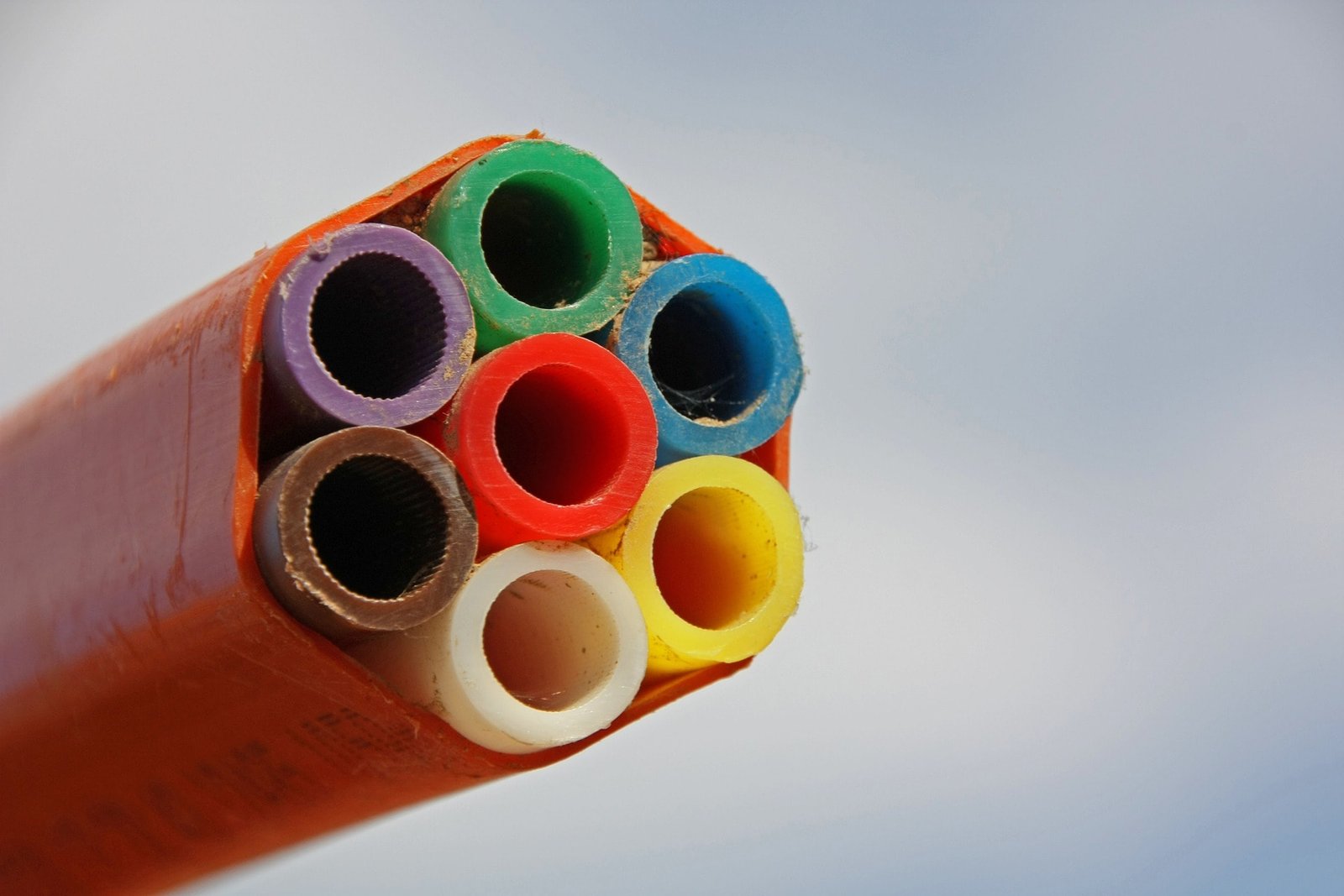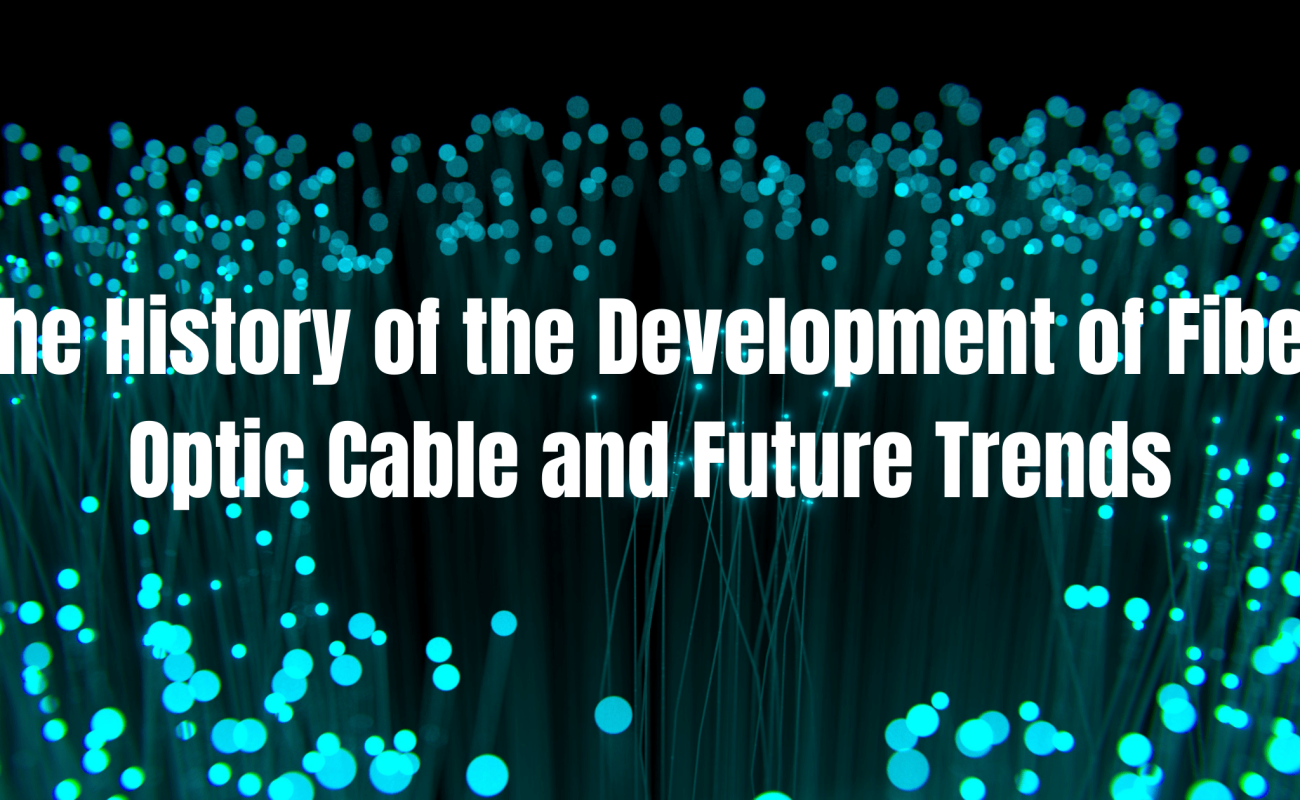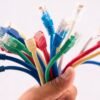Fiber-optic cables have revolutionized data transmission around the globe and are used in multiple applications, all thanks to it’s resistibility to noise and to the effect of EM interference.
The fiber optic cable technology has an interesting history and was first invented in the 1920s. Many advancements have been made in this amazing technology with the passage of time. This has resulted in the vast use of fiber optic cables in many applications including the internet, the medical industry, and mobile phone communication. These cables will further assist in the development of high-tech systems in the future.
Continue reading to learn more about fiber optic cables’ historical background, present applications, and prospective future.
The predecessor of fiber optic cable:
The Telegraph
In the 1800s, electric telegraphy was developed as a way to communicate with each other over long distances. The first successful experiment was performed by Sir Charles Wheatstone and William Fothergill Cook in 1837. This technology is still being used today if you’ve ever dialed an international number for a phone call or sent someone abroad flowers! Electric telegraphy laid the groundwork for future fiber optic cable development; it made it possible to send messages over large distances without having to rely on transporting people at high costs (and putting their lives at risk traveling such dangerous terrain).
The Telephone:
Alexander Graham Bell patented his design for “the Telephone” in 1876 and installed the first telephone line in 1878. Although it’s surprising that it took this long for the telephone to be invented, people at that time were already imagining a future where they could communicate via voice without having to rely on transporting their voices physically to someone else – just as electric telegraphy had done.
The Copper Wire:
The main predecessor of fiber optic cable is the copper wire. This is the primary method of moving data for wired networks. Wires are limited to a certain distance and quality before they start to degrade and lose signal strength. Fiber optics allow data signals to travel for much longer because the cables do not deteriorate as quickly over time.
Telephone cables made of copper wires were the most common way to send and receive data between computers and other electronic devices. These devices went by names such as “modems,” which would translate digital code into audio signals so pictures and text could be transmitted through telephone lines. The problem with these cables is that they quickly became overloaded, and there was a maximum rate beyond which no more information could be sent. A faster method had to be developed in order for modern technologies such as the internet, cell phones, and streaming services to function effectively.
Copper wire is used in most communications equipment that uses electricity to transmit data. Data can be transferred through the copper wire at a rate of 1-2 Mb/s, where it takes 100 million bits for one second to reach this speed. There are several drawbacks to using copper wire, which are heating, sparking, and cost. Since there are newer methods to transmit information at faster rates, copper wires are far less used now than they were before fiber optic cables were invented.
Who invented the fiber optic cable?
Fiber optic cables were invented by Dr. Narinder Singh Kapany, who was born in Amritsar, India on March 31, 1926. He patented the first fiber-optic cable in 1964. He was able to take an image using light and bounce it off of a mirror so the same thing could be observed on the other side, proving his method worked. While investigating ways to use light in communications, Narinder Singh Kapany created this fiber optic cable that would go on to revolutionize the way we transmit data for years to come.
The first data transmission over fiber took place in 1974, and that year saw two major developments in the new technology: single-mode fiber was introduced, and the first installation outside North America of undersea fiber-optic cable took place.
When did fiber optic cable appear in front of our eyes?
Since fiber optic cables transmit data at much faster rates than copper wires, they are used in technology that uses electricity to communicate, such as computers and smartphones. Though the invention of the first optical fibers was made back in 1965, it wasn’t until the 1990s before optical fibers became widely used for communication purposes.
1965: First Optical Fiber Made from Plastic
In 1965, Daniel Noble demonstrated the first plastic fiber made of polyethylene. It was a long strand that could transmit images over a distance of 50 meters. In 1970, he showed his invention to Kong Harald Jorn Wang at The Shirriff-Mew Research Centre in Denmark. Together, they improved Daniel Noble’s original design by making the plastic core smaller. They called it “Optical Fiber” and patented the idea in 1974.
1960s-1980s: Optical Fibers for Communications
In 1970, scientists at Corning Glass Works made optical fibers that were able to transmit images over long distances without deteriorating. In 1973, the first long-distance line using optical fibers was created. The first commercial cables were mono-mode fiber(MMF), meaning they could only send a single ray of light at a time. This means data speeds had to be reduced in order to make sure all the rays of light reached their destination successfully.
1980s: Plastic Optical Fibers for Communications
At the beginning of the 1980s, plastic optical fibers became all the rage. They were cheap to produce and compatible with existing fiber optic technology. By 1983 some companies used plastic fibers to transmit data over long distances

1990s-Present: Multi-Mode Fibers for Communication
Multi-mode fibers had shortfalls due to their limited bandwidth. They could not be used for long-distance communication, but they were cheap to produce and easy to manufacture which is why they are still used on the internet today.
2000s: Single-Mode Fiber for Communications
Single-mode fibers are made of glass to reduce signal loss over longer distances. They are more expensive than multimode fibers, but they have the capacity to carry huge amounts of data at very high speeds.
2015-Present: Plastic Optical Fibers for Communications
Starting in 2015, plastic optical fibers are being used to transmit data over short distances on a large scale. This can be seen through innovations such as Google’s Project Loon which uses computer systems with balloons that are equipped with cell service antennas to beam internet to rural areas.
Where does fiber optic cable fit into our lives now?
-Internet services
Fiber optic cable has contributed largely to the expansion of internet services. The use of fiber optic cable has enabled faster internet speeds, increased broadband capacity, and greater internet penetration. The increase in the speed of data transmission has led to an increase in the volume of data that can be transmitted over fiber optic cable.
Broadband capacity can be increased by installing more fibers inside a particular cable. Fiber optics also allow for flexible deployment because it does not require direct line-of-sight transmission as copper cables do. This means that areas difficult to reach with copper cables are now accessible because fiber optics is also resistant to noise interference and attenuation.
-Voice and video services
An emerging trend in the telecommunications industry is the increasing use of fiber optic cables for voice and video services. The primary reason for this is because one end of a fiber optic cable can be connected to a telephone exchange and its other end connected to a telephone at the customer’s premises. This means that all voice and video signals transmitted on copper wires at the telephone exchange will also be transmitted on the fiber optic cable.
-Entertainment
Fiber optic cable can also be used to transmit light beams of information such as sound and images for entertainment purposes. This can be done by transmitting beams of light into the fibers at the transmitter, then splitting two or more beams of light at the receiver. This process is repeated at several locations along the length of the fiber optic cable.
-Medical services
One of the most underutilized uses of fiber optic cable is medical services, but it has many promising applications including dental work, and operating rooms. Dental work is able to be performed using fiber optics for illumination and magnification. Fiber optic technology can also reflect images in operating rooms through the use of flash lamp sources with optical fibers.
-Telecommunication application in automobiles
Fiber optic cable technology is used extensively in telecommunication applications in automobiles to transmit information related to the car such as speed and engine performance. This has allowed automakers to reduce the amount of wiring in cars which reduces weight and increases fuel efficiency.
-Industrial uses
Fiber optic cable is used extensively in various applications within the industrial setting. This includes machines such as medical imaging equipment, motor control centers, factory automation systems, and process control systems. Fiber optics can be used to transmit large amounts of data quickly and with little noise interference which allows for the use of powerful instruments without interference. These benefits have allowed for fiber optic cables to replace copper wire in these applications.
-Telecommunications services
In the telecommunications industry, fiber optic cables allow service providers to reduce the number of links between their head end and other points on their network. This reduces signal attenuation and other noise interference associated with long runs of copper wire which creates a stronger and more reliable signal.
Fiber optic cables also allow service providers to offer greater internet speeds, increased broadband capacity, and large amounts of data transfer in order to provide services such as television and telephone services.
-Medical devices
Fiber optic cable is used in medical applications for endoscopic procedures which help physicians in the diagnosis and treatment of disease and in surgical procedures. Fiber optic technology is used in endoscopes because of its ability to transmit light without significant attenuation over long distances which allows for more accurate diagnosis and treatment.
-Undersea cables
Fiber optic cable is used extensively in submarine communications cables (also known as undersea cables). These fiber optic cables are laid on the surface of the seabed to transmit information between continents which allows for international telecommunication. Fiber optic cables are used because they are resistant to noise interference and other conditions found underwater.
-Military applications
Due to its resistance to noise interference, fiber optic cables can be used to send encrypted signals without fear of interception. The military has extensively utilized fiber optics technology in order to send signals to drones, fighter planes, and other military vehicles.
-Incredible speed and bandwidth
The development of fiber optic cables has led to the emergence of technologies that are capable of incredible speeds and bandwidths. These include FTTH, FTTC, and FTTB. These three generations of fiber optic technology have increased the speed and performance capabilities of fiber optic cables.
With the recent development of fiber optic cable, we have seen an incredible speed and bandwidth of the data transmission. With this speed, we’re able to transmit our information with great ease. Fiber optics is a safe, reliable and lightning fast data transmission that has been a reliable source for information for years now. Big companies like Google and Facebook are using these cables because they know best about their accuracy and dependability.
-Multiuse applications
This type of cable is beneficial to humans because, unlike copper wire which has a limited range and can only be used for one thing, fiber optics can be used in many different ways. This makes it very cost effective and also reduces waste by reducing the amount of components needed to transmit information. With the use of fiber optics for communication purposes, we can reduce the amount of pollution and traffic caused by electrical cables.
Where will fiber optics be used in future?
Over the course of the next few years, we will see a continued growth in the amount of data that is transmitted over long distances via fiber optic cable without requiring any amplification or regeneration.
There is no distance limit on what can be achieved through this medium which means it can transmit information anywhere without any loss whatsoever which makes it ideal for transporting large amounts of data across long distances.
-Increased broadband capacity
One way that fiber optics will help enhance our society is by increasing broadband capacity. This can be achieved by deploying more fibers in existing cables and designing new cables with even more fibers. As time goes on, we may witness an increase in the sheer volume of data that can be transmitted over fiber optic cable as well as a decrease in per-fiber costs.
While fiber optic cable systems are already being used to provide Internet access to homes, this trend is expected to continue into the future as more and more people become fed up with traditional services such as cable modems which are slow and limit bandwidth consumption. With FTTH becoming widespread , it is expected that 90% of households will have access to high speed broadband connection through this medium.
-Long distance networks
Another place where we will see fiber optic technology used more frequently is long-distance networks. The distance over which data is transmitted over fiber optic cable can be up to 200,000 km without amplification while copper cables require repeaters every 100-200 meters. It is then not surprising that undersea cables have been almost completely replaced with fiber optic cables in the past few decades.
-High speed links between data centers
Data centers are expensive pieces of real estate where companies house their servers and other equipment required to run their businesses online. Fiber optic cables will play a key role in linking these data centers because they provide an enormous amount of bandwidth necessary for transferring large amounts of information between different places at high speeds.
-Home networking
Fiber optics can also be used to transfer information inside homes, allowing for faster communication between different devices inside the home. This includes computers, appliances, and even entertainment devices such as televisions. It will become easier for people to connect their smartphones, tablets, TVs, laptops etc. wirelessly to each other without worrying about bandwidth constraints or security issues.
-Efficient network management systems
There are many different ways that fiber optic technology can be used to improve the management efficiency of networks. The use of wavelength-division multiplexing has allowed for very efficient use of broadband connections by being able to send data over different wavelengths.
It is also possible to use passive optical network technology with fiber optics to efficiently link different networks together, thereby allowing for more streamlined operation.
-High capacity submarine cable systems
Submarine cable systems will continue to play a major role in providing high bandwidth connections between countries especially in regions that do not have land borders. Not only is it the most cost efficient option for countries which are separated by large bodies of water, but they also provide more security against natural disasters such as tsunamis and earthquakes which can destroy terrestrial lines of communication.
-Fiber to the home
Another major trend is in fiber optic technology being implemented in homes themselves, also known as Fiber to the Home or FTTH. One of the main benefits of this is that it eliminates the need for multiple cables when connecting devices which means less cabling within walls and more convenient hookups.
-Continued growth for mobile devices
One of the best ways to keep up with new technological developments is through mobile devices because they usually come installed with all the latest software and applications. Fiber optic technology has become very popular with mobile devices in recent years and this trend is expected to continue due to the increased demand for faster speed for video streaming and downloads, which require large bandwidth capacities.
-Expansion of ISPs and telecommunications providers
As more and more people become connected to the internet, we will see an increase in demand for ISPs and telecommunications providers. This is especially true in developing regions where access to high speed broadband has been difficult due to geographical constraints such as long distances or landlocked countries. Fiber optic technology helps solve this problem by providing reliable high speed connection options.
-Use of shared storage media
Accessing large amounts of data over networks requires a lot of bandwidth capacity which can quickly get clogged up if it is not used efficiently. One way that bandwidth usage can be optimized is through the use of shared storage media such as Network Attached Storage (NAS) devices cloud computing so that all network users can access and share data quickly and easily.
-Improved power grid management
Fiber cable can also be used in conjunction with renewable energy sources such as solar panels to provide a faster and more reliable way of sending data from the source to the consumer. A fiber optic cable system running from a solar panel array to a nearby house is much easier and cheaper than running electricity over long distances.
-Reduced bandwidth costs
In recent years, we have seen that the price of bandwidth has been steadily decreasing due to new developments in broadband technologies and reductions in the cost of raw materials (such as glass).
Fiber optic cables will continue this trend because there is very little physical material involved compared to traditional copper based systems which means more savings for ISPs and telecommunication providers who purchase their own equipment.
Final Words:
Fiber optic cables are an important part of the information and telecommunication industry, as they transmit data with higher bandwidths than other types of cables. Fiber optics can be found in a variety of applications such as internet connections, telephone lines, cable TV signals and much more.
With the development of new technologies that use light for transmission rather than electricity or radio waves, we may see fiber copper cable become obsolete within 10 years due to its limited capacity- current technology has already surpassed it by leaps and bounds!
The future is looking bright for this type of wire; there will always be some application where these wires shine brighter than their competitors. This article provided you with an overview on how fiber optic cable works and what it’s used for so now you can impress your friends with a little bit of knowledge at the next dinner party you attend.










